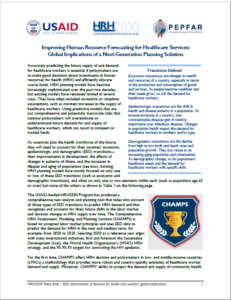16 Dec Improving Human Resource Forecasting for Healthcare Services: Global Implications of a Next-Generation Planning Solution
Accurately predicting the future supply of and demand for healthcare workers is essential if policymakers are to make smart investments in human resources for health (HRH) and efficiently allocate scarce funds. HRH planning models have become increasingly sophisticated over the past two decades, but existing models have remained limited in several ways. They have often included unrealistic or simplistic assumptions, such as constant increases in the supply of healthcare workers. Using predictive models that are not comprehensive and potentially inaccurate risks that national policymakers will overestimate or underestimate future demand for and supply of healthcare workers, which can result in misspent or wasted funds.
HRH2030 created a new econometric model – the Comprehensive HRH Assessment, Modeling, and Planning Solution (CHAMPS) – to measure the impact of economic, epidemiological, and demographic (EED) transitions on the health labor market, including physicians, nurses/midwives, and community health workers. By exploring the forces influencing health worker supply and demand, this model allows us to provide HRH projections and offer insight to what government decision-makers and planners must do to prepare for health labor market changes that lie ahead.
This technical brief, Improving Human Resource Forecasting for Healthcare Services: Global Implications of a Next-Generation Planning Solution, describes the CHAMPS methodology, based on the analysis of HRH and EED data from 84 LMICs. The full report about the creation and application of CHAMPS on a global level, Health Workforce Skills Mix and Economic, Epidemiological, and Demographic (EED) Transitions in LMICs: Analysis and Econometric Modeling can be accessed here.
In addition, HRH2030 conducted a country-level analysis for Ghana to provide an example of the predictive and planning power CHAMPS can deliver to country HRH stakeholders. A separate brief with the results of that study, Applying a Next-Generation Approach to Comprehensive Planning for Human Resources for Health in Ghana, can be accessed here.
Associated Content
Three Questions with Dr. Pierre Nguimkeu: Forecasting the Supply & Demand for HRH
Country: Global
Resource Type: Report
Topic: Skill mix and competency
DOWNLOAD






